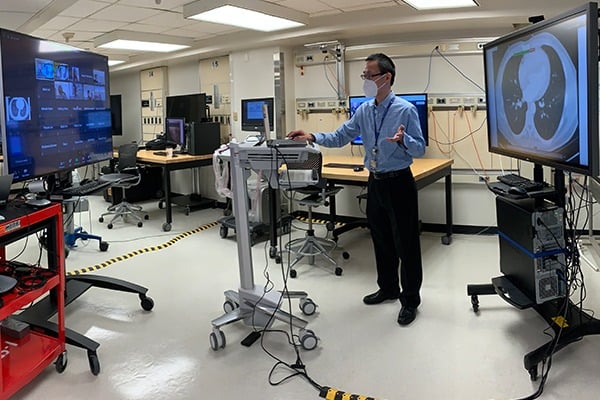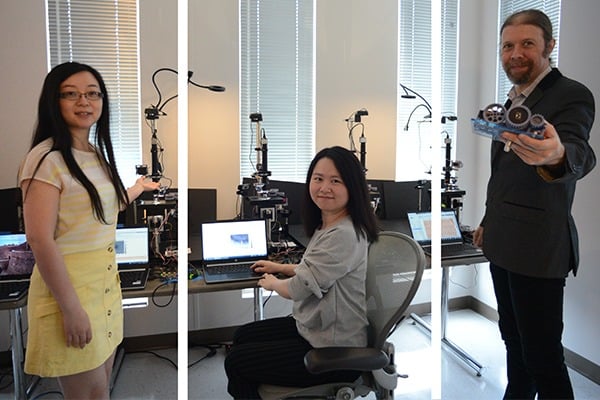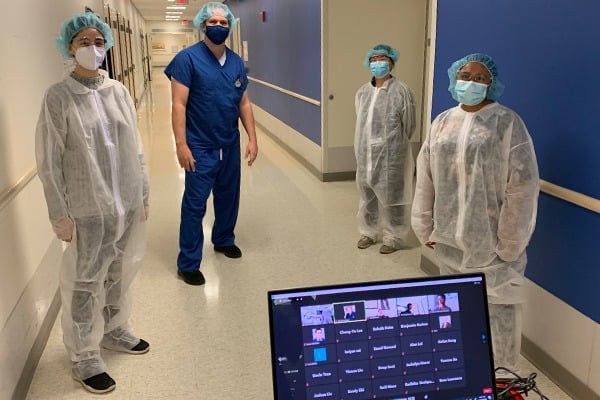Building Circuits for Personal Electrocardiograms
One such instructor was Eileen Haase, an associate teaching professor. When the pandemic hit, she had to quickly adjust her freshman course, BME Basecamp, to an online format. The course typically asks students to create a project in the lab; instead, she and her students discussed the idea of an app they could create at home.
“They really weren’t able to build anything, which was frustrating,” Haase says. “A lot of the design process is iterative—building and testing, re-building and re-testing—and the freshmen could not do that unless they had the materials themselves.”
As a result of experiences faced that first pandemic semester, she worked assiduously to get a more hands-on experience ready for fall. Haase redesigned the course, pulling some lectures she already had created for a Biomedical Engineering Innovation course for high school students. She also worked with a Pennsylvania-based company to send custom engineering kits with bread boards, microprocessors, resistors, volt meters, and other parts to students worldwide so they could build a temperature sensor and another biosensor from home, working in teams online.
“Since we had very limited time to get all this available, I took advantage of online modules from other courses that had already been tested, and adapted them for our BME undergrads,” Haase says. “I had some phenomenal TAs I worked with on this transition, so I can’t take all the credit. Our goal was to make sure our students had a genuine, hands-on experience.”
In her junior-level Computational Medicine Cardiology Lab, Haase normally used frogs during labs so that students could study beating hearts. Since that would not have worked for the course’s online version, Haase pulled some talks and materials from Johns Hopkins’ Engineering for Professionals online curriculum, and had custom electronics kits sent to students so they, too, could work from home. During the course, students built circuits to measure their hearts’ electrical activity, which could be analyzed and displayed as an electrocardiogram (ECG) using the programming language MATLAB.
“They never had to build their own circuit before to acquire their ECG,” Haase says. “Students told me that obtaining their own ECG was ‘cool,’ ‘incredibly fun,’ and ‘the only hands-on project’ they had all semester. That’s the essence of BME, to get data from living tissue into a computer, so they reported the project made them really feel like an engineer.”
However, just when Haase thought she had everything worked out, new wrinkles appeared. The kit company was waiting on parts from China, which were delayed due to the pandemic, forcing Haase to extend or rework some deadlines. Students had to learn troubleshooting skills and patiently redo parts of their circuit if resistors or other parts broke during the build process.
“I had been used to teaching online because I teach with Engineering for Professionals, but to have to suddenly put so many courses online was extremely challenging,” she says. “It was the most exhausting year of my life. There were some times I didn’t think I would be able to do it all. It really helped to know there were resources within the Engineering for Professionals and Engineering Innovations programs I could use, such as professionally developed online videos, quizzes, and materials lists that I could pull from to help put together stimulating lab classes relatively quickly.”
The mail-home kits helped teams gain valuable hands-on experiences and get a taste of the practical aspects of the design process, from brainstorming ideas and writing codes to building circuits and setting up the boards and sensors, said Peggy Li, a first-year undergraduate student. Her team worked extensively with an obstacle sensor using an infrared light to detect the number of people and objects that pass by. They also did some coding so an attached LED light would turn on and change colors as more objects passed it.
“Our overall design idea was to model a COVID-19 population density sensor, where the sensor could be installed in buildings and provide real-time data on how many people are inside as to help individuals avoid large indoor crowds,” Li said. “I’m really grateful that I got to work with these kits even at home, and I definitely felt that putting what we learned into practice helped to both solidify my understandings of concepts and make the course more fun and interactive.”
Haase also shared her tips with other colleagues. Instructors with the Cell and Tissue Engineering Lab pulled materials from the Engineering for Professionals Cell and Tissue Engineering course to pivot some of their classes from in-person to online, too.




